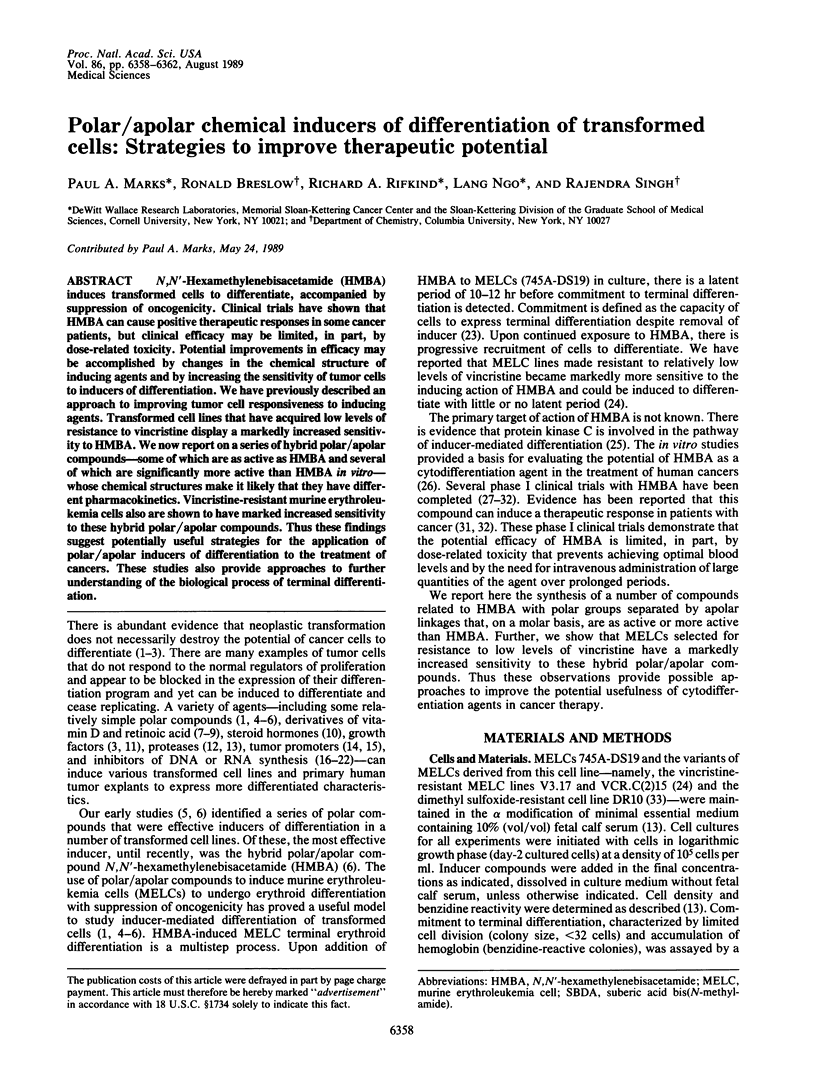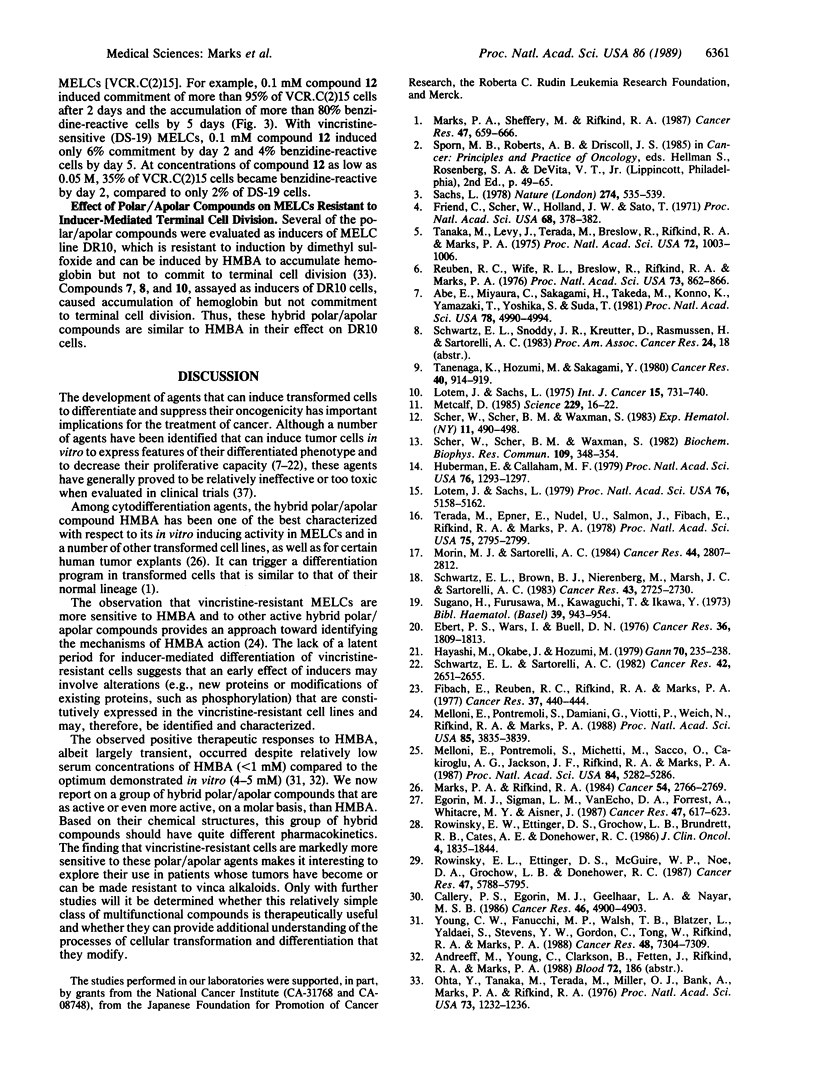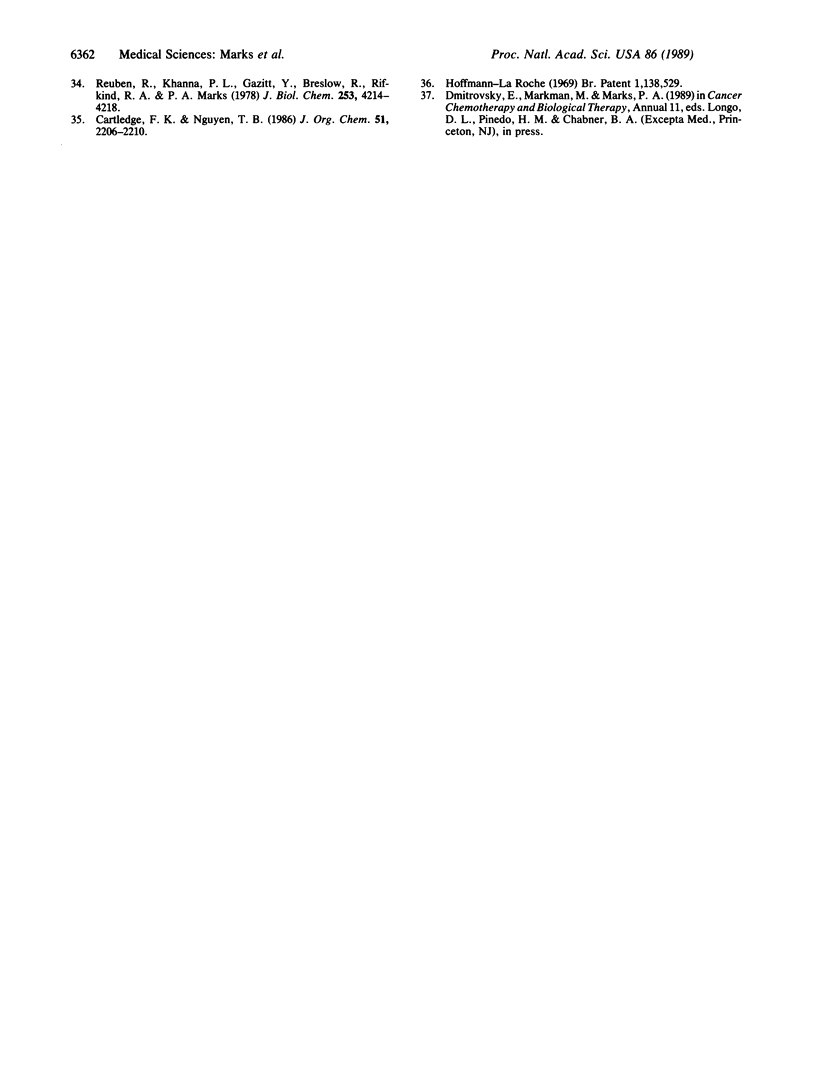Abstract
N,N'-Hexamethylenebisacetamide (HMBA) induces transformed cells to differentiate, accompanied by suppression of oncogenicity. Clinical trials have shown that HMBA can cause positive therapeutic responses in some cancer patients, but clinical efficacy may be limited, in part, by dose-related toxicity. Potential improvements in efficacy may be accomplished by changes in the chemical structure of inducing agents and by increasing the sensitivity of tumor cells to inducers of differentiation. We have previously described an approach to improving tumor cell responsiveness to inducing agents. Transformed cell lines that have acquired low levels of resistance to vincristine display a markedly increased sensitivity to HMBA. We now report on a series of hybrid polar/apolar compounds--some of which are as active as HMBA and several of which are significantly more active than HMBA in vitro--whose chemical structures make it likely that they have different pharmacokinetics. Vincristine-resistant murine erythroleukemia cells also are shown to have marked increased sensitivity to these hybrid polar/apolar compounds. Thus these findings suggest potentially useful strategies for the application of polar/apolar inducers of differentiation to the treatment of cancers. These studies also provide approaches to further understanding of the biological process of terminal differentiation.
Full text
PDF




Selected References
These references are in PubMed. This may not be the complete list of references from this article.
- Abe E., Miyaura C., Sakagami H., Takeda M., Konno K., Yamazaki T., Yoshiki S., Suda T. Differentiation of mouse myeloid leukemia cells induced by 1 alpha,25-dihydroxyvitamin D3. Proc Natl Acad Sci U S A. 1981 Aug;78(8):4990–4994. doi: 10.1073/pnas.78.8.4990. [DOI] [PMC free article] [PubMed] [Google Scholar]
- Callery P. S., Egorin M. J., Geelhaar L. A., Nayar M. S. Identification of metabolites of the cell-differentiating agent hexamethylene bisacetamide in humans. Cancer Res. 1986 Oct;46(10):4900–4903. [PubMed] [Google Scholar]
- Ebert P. S., Wars I., Buell D. N. Erythroid differentiation in cultured Friend leukemia cells treated with metabolic inhibitors. Cancer Res. 1976 May;36(5):1809–1813. [PubMed] [Google Scholar]
- Egorin M. J., Sigman L. M., Van Echo D. A., Forrest A., Whitacre M. Y., Aisner J. Phase I clinical and pharmacokinetic study of hexamethylene bisacetamide (NSC 95580) administered as a five-day continuous infusion. Cancer Res. 1987 Jan 15;47(2):617–623. [PubMed] [Google Scholar]
- Fibach E., Reuben R. C., Rifkind R. A., Marks P. A. Effect of hexamethylene bisacetamide on the commitment to differentiation of murine erythroleukemia cells. Cancer Res. 1977 Feb;37(2):440–444. [PubMed] [Google Scholar]
- Friend C., Scher W., Holland J. G., Sato T. Hemoglobin synthesis in murine virus-induced leukemic cells in vitro: stimulation of erythroid differentiation by dimethyl sulfoxide. Proc Natl Acad Sci U S A. 1971 Feb;68(2):378–382. doi: 10.1073/pnas.68.2.378. [DOI] [PMC free article] [PubMed] [Google Scholar]
- Hayashi M., Okabe J., Hozumi M. Sensitization of resistant myeloid leukemia clone cells by anti-cancer drugs to factor-stimulating differentiation. Gan. 1979 Apr;70(2):235–238. [PubMed] [Google Scholar]
- Huberman E., Callaham M. F. Induction of terminal differentiation in human promyelocytic leukemia cells by tumor-promoting agents. Proc Natl Acad Sci U S A. 1979 Mar;76(3):1293–1297. doi: 10.1073/pnas.76.3.1293. [DOI] [PMC free article] [PubMed] [Google Scholar]
- Lotem J., Sachs L. Induction of specific changes in the surface membrane of myeloid leukemic cells by steroid hormones. Int J Cancer. 1975 May 15;15(5):731–740. doi: 10.1002/ijc.2910150504. [DOI] [PubMed] [Google Scholar]
- Lotem J., Sachs L. Regulation of normal differentiation in mouse and human myeloid leukemic cells by phorbol esters and the mechanism of tumor promotion. Proc Natl Acad Sci U S A. 1979 Oct;76(10):5158–5162. doi: 10.1073/pnas.76.10.5158. [DOI] [PMC free article] [PubMed] [Google Scholar]
- Marks P. A., Rifkind R. A. Differentiation modifiers. Cancer. 1984 Dec 1;54(11 Suppl):2766–2769. doi: 10.1002/1097-0142(19841201)54:2+<2766::aid-cncr2820541424>3.0.co;2-n. [DOI] [PubMed] [Google Scholar]
- Marks P. A., Sheffery M., Rifkind R. A. Induction of transformed cells to terminal differentiation and the modulation of gene expression. Cancer Res. 1987 Feb 1;47(3):659–666. [PubMed] [Google Scholar]
- Melloni E., Pontremoli S., Damiani G., Viotti P., Weich N., Rifkind R. A., Marks P. A. Vincristine-resistant erythroleukemia cell line has marked increased sensitivity to hexamethylenebisacetamide-induced differentiation. Proc Natl Acad Sci U S A. 1988 Jun;85(11):3835–3839. doi: 10.1073/pnas.85.11.3835. [DOI] [PMC free article] [PubMed] [Google Scholar]
- Melloni E., Pontremoli S., Michetti M., Sacco O., Cakiroglu A. G., Jackson J. F., Rifkind R. A., Marks P. A. Protein kinase C activity and hexamethylenebisacetamide-induced erythroleukemia cell differentiation. Proc Natl Acad Sci U S A. 1987 Aug;84(15):5282–5286. doi: 10.1073/pnas.84.15.5282. [DOI] [PMC free article] [PubMed] [Google Scholar]
- Metcalf D. The granulocyte-macrophage colony-stimulating factors. Science. 1985 Jul 5;229(4708):16–22. doi: 10.1126/science.2990035. [DOI] [PubMed] [Google Scholar]
- Morin M. J., Sartorelli A. C. Inhibition of glycoprotein biosynthesis by the inducers of HL-60 cell differentiation, aclacinomycin A and marcellomycin. Cancer Res. 1984 Jul;44(7):2807–2812. [PubMed] [Google Scholar]
- Ohta Y., Tanaka M., Terada M., Miller O. J., Bank A., Marks P., Rifkind R. A. Erythroid cell differentiation: murine erythroleukemia cell variant with unique pattern of induction by polar compounds. Proc Natl Acad Sci U S A. 1976 Apr;73(4):1232–1236. doi: 10.1073/pnas.73.4.1232. [DOI] [PMC free article] [PubMed] [Google Scholar]
- Reuben R. C., Khanna P. L., Gazitt Y., Breslow R., Rifkind R. A., Marks P. A. Inducers of erythroleukemic differentiation. Relationship of structure to activity among planar-polar compounds. J Biol Chem. 1978 Jun 25;253(12):4214–4218. [PubMed] [Google Scholar]
- Reuben R. C., Wife R. L., Breslow R., Rifkind R. A., Marks P. A. A new group of potent inducers of differentiation in murine erythroleukemia cells. Proc Natl Acad Sci U S A. 1976 Mar;73(3):862–866. doi: 10.1073/pnas.73.3.862. [DOI] [PMC free article] [PubMed] [Google Scholar]
- Rowinsky E. K., Ettinger D. S., Grochow L. B., Brundrett R. B., Cates A. E., Donehower R. C. Phase I and pharmacologic study of hexamethylene bisacetamide in patients with advanced cancer. J Clin Oncol. 1986 Dec;4(12):1835–1844. doi: 10.1200/JCO.1986.4.12.1835. [DOI] [PubMed] [Google Scholar]
- Rowinsky E. K., Ettinger D. S., McGuire W. P., Noe D. A., Grochow L. B., Donehower R. C. Prolonged infusion of hexamethylene bisacetamide: a phase I and pharmacological study. Cancer Res. 1987 Nov 1;47(21):5788–5795. [PubMed] [Google Scholar]
- Sachs L. Control of normal cell differentiation and the phenotypic reversion of malignancy in myeloid leukaemia. Nature. 1978 Aug 10;274(5671):535–539. doi: 10.1038/274535a0. [DOI] [PubMed] [Google Scholar]
- Scher W., Scher B. M., Waxman S. Proteases act synergistically with low molecular weight inducers to stimulate mouse erythroleukemia cell differentiation. Exp Hematol. 1983 Jul;11(6):490–498. [PubMed] [Google Scholar]
- Scher W., Scher B. M., Waxman S. Proteases stimulate mouse erythroleukemia cell differentiation and multiplication. Biochem Biophys Res Commun. 1982 Nov 30;109(2):348–354. doi: 10.1016/0006-291x(82)91727-2. [DOI] [PubMed] [Google Scholar]
- Schwartz E. L., Brown B. J., Nierenburg M., Marsh J. C., Sartorelli A. C. Evaluation of some anthracycline antibiotics in an in vivo model for studying drug-induced human leukemia cell differentiation. Cancer Res. 1983 Jun;43(6):2725–2730. [PubMed] [Google Scholar]
- Schwartz E. L., Sartorelli A. C. Structure-activity relationships for the induction of differentiation of HL-60 human acute promyelocytic leukemia cells by anthracyclines. Cancer Res. 1982 Jul;42(7):2651–2655. [PubMed] [Google Scholar]
- Sugano H., Furusawa M., Kawaguchi T., Ikawa Y. Enhancement of erythrocytic maturation of Friend virus-induced leukemia cells in vivo. Bibl Haematol. 1973;39:943–954. doi: 10.1159/000427927. [DOI] [PubMed] [Google Scholar]
- Takenaga K., Hozumi M., Sakagami Y. Effects of retinoids on induction of differentiation of cultured mouse myeloid leukemia cells. Cancer Res. 1980 Mar;40(3):914–919. [PubMed] [Google Scholar]
- Tanaka M., Levy J., Terada M., Breslow R., Rifkind R. A., Marks P. A. Induction of erythroid differentiation in murine virus infected eythroleukemia cells by highly polar compounds. Proc Natl Acad Sci U S A. 1975 Mar;72(3):1003–1006. doi: 10.1073/pnas.72.3.1003. [DOI] [PMC free article] [PubMed] [Google Scholar]
- Terada M., Epner E., Nudel U., Salmon J., Fibach E., Rifkind R. A., Marks P. A. Induction of murine erythroleukemia differentiation by actinomycin D. Proc Natl Acad Sci U S A. 1978 Jun;75(6):2795–2799. doi: 10.1073/pnas.75.6.2795. [DOI] [PMC free article] [PubMed] [Google Scholar]
- Young C. W., Fanucchi M. P., Declan Walsh T., Baltzer L., Yaldaei S., Stevens Y. W., Gordon C., Tong W., Rifkind R. A., Marks P. A. Phase I trial and clinical pharmacological evaluation of hexamethylene bisacetamide administration by ten-day continuous intravenous infusion at twenty-eight-day intervals. Cancer Res. 1988 Dec 15;48(24 Pt 1):7304–7309. [PubMed] [Google Scholar]


